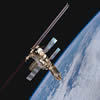
Dennis Jacobs’ research is out of this world. Literally. Back in March, astronauts from the space shuttle Endeavour installed an experiment devised by the Notre Dame chemistry professor on the outside of the International Space Station. The research, conceived by the ND chemist who also serves the University as a vice president and associate provost, is designed to test how well a variety of materials stand up to the rigors of near-Earth orbit.
While friction from the atmosphere isn’t a problem orbiting a couple hundred miles above Earth, the International Space Station is constantly bombarded by energetic atoms, ions, electrons and radiation, Jacobs says. Over time this constant assault has a corrosive effect on most materials.
Every 20 minutes for the next year, the ND experiment will send data back to Earth on the state of the approximately 100 samples that include everything from graphite and polyethylene to exotic artificial substances. At year’s end, astronauts from another shuttle mission will return the experiment to Jacobs’ lab for further analysis. By gaining a detailed understanding of how the various materials erode in the unique environment of near-Earth orbit, the ND researcher and his colleagues hope to discern the most durable materials to use in space.